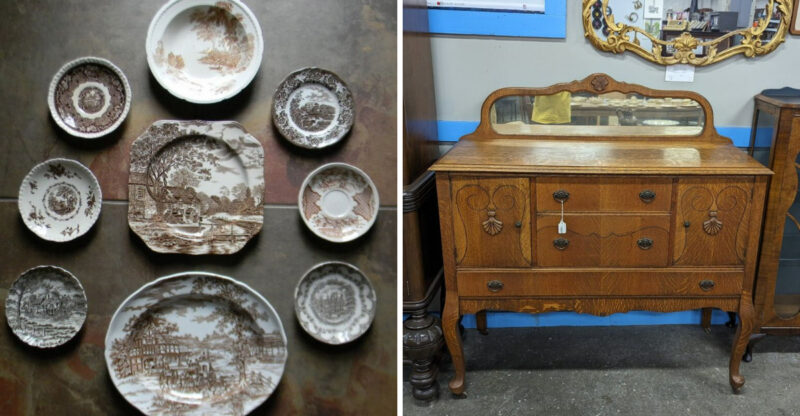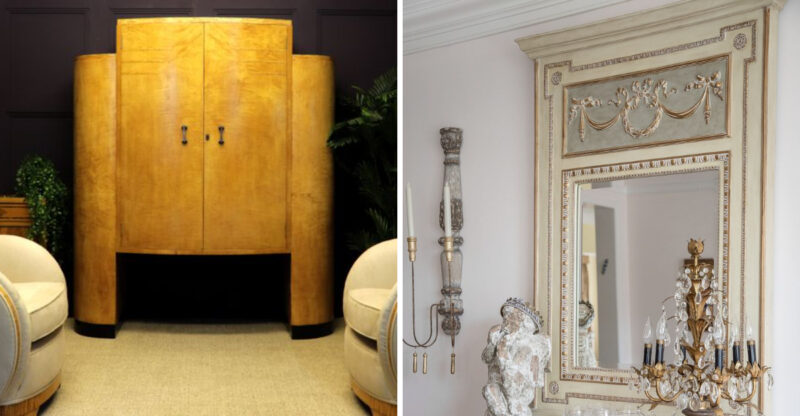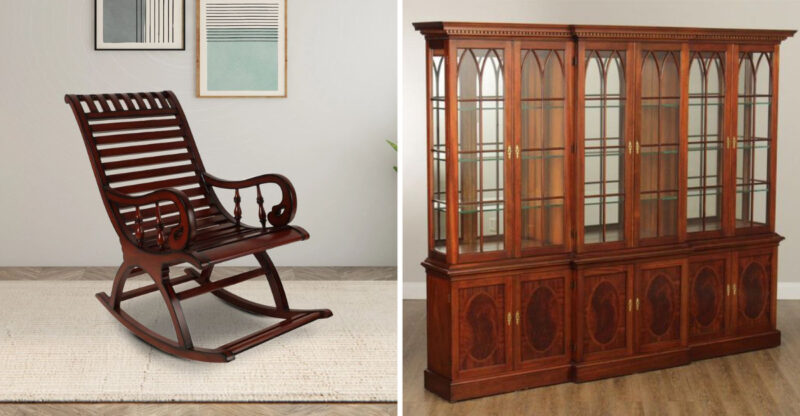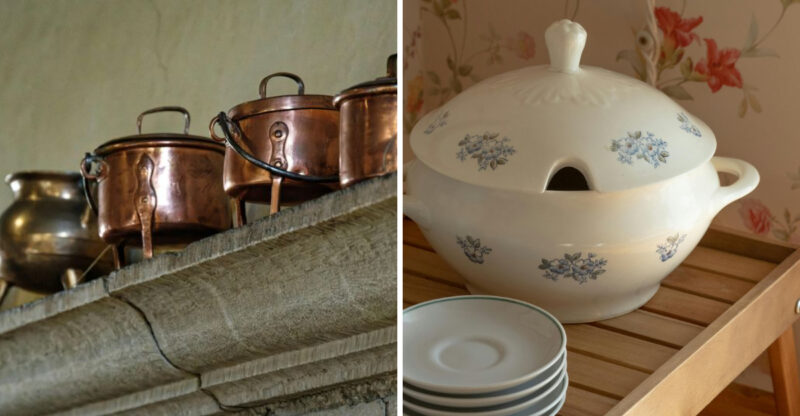13 Things Worth Hunting For At Your Local Thrift Store
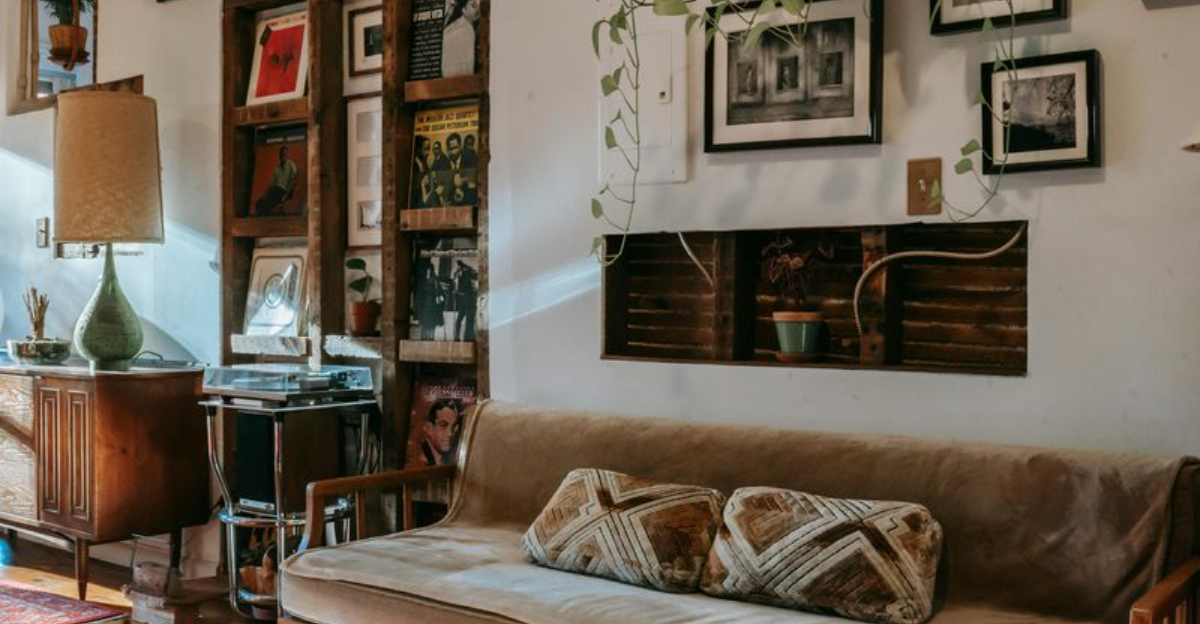
Thrift stores are full of hidden treasures just waiting for someone with a keen eye. Shopping secondhand isn’t just budget-friendly it’s a chance to find unique pieces with character and history that you won’t see in mass-produced stores.
While availability and condition can vary, these 13 items are especially worth seeking out on your next thrift store adventure, offering both style and practicality for your home.
1. Vintage Wooden Chairs
Old wooden chairs from the 50s-70s often sell for a fraction of their value at thrift stores. I’ve found solid oak, walnut, and teak pieces that needed nothing more than a light cleaning to look spectacular.
The craftsmanship in these older chairs simply doesn’t exist in today’s mass-produced furniture. Look for dovetail joints, sturdy construction, and chairs that feel solid when you wiggle them.
Even chairs with minor damage can be worth grabbing a wobbly leg is usually fixable with wood glue, and worn seats can be easily reupholstered for under $20, turning a $15 thrift store find into a $200+ statement piece.
2. Mid-Century Side Tables
Mid-century side tables are absolute gold mines at thrift stores. Many people donate these treasures without realizing their true value, which means you can snag designer-quality pieces for pennies on the dollar.
What makes these tables special is their timeless design clean lines, tapered legs, and functional simplicity that works with almost any decor style. I found my favorite teak side table for just $12, while similar reproductions sell for $150+ in trendy furniture stores.
Check for solid wood construction and examine the underside for maker’s marks or labels sometimes you’ll discover a legitimate designer piece that could be worth hundreds!
3. Antique Picture Frames
Antique frames transform ordinary photos and art into extraordinary displays. The ornate craftsmanship and quality materials in vintage frames simply can’t be matched by today’s mass-produced options.
When hunting for frames, I always check for solid wood construction and hand-carved details. Don’t worry about the existing artwork or photos you’re after the frame itself. Even damaged frames shouldn’t be overlooked, as minor chips or missing ornaments can often be repaired with wood putty.
My favorite thrift store frame cost just $3, but after professional cleaning revealed its gold leaf finish, an appraiser valued it at over $75. Large vintage frames are particularly valuable, so grab them when you spot them!
4. Brass or Copper Lamps
Metal lamps from decades past offer incredible quality compared to today’s flimsy alternatives. The substantial weight of vintage brass or copper lamps signals their durability and value.
If you spot tarnished metal lamps, don’t walk away! That dark patina is actually protecting the metal and can be easily cleaned with metal polish to reveal stunning shine underneath. I once transformed a blackened $8 brass lamp into a gleaming showpiece after just 20 minutes of polishing.
When examining these lamps, check that the wiring isn’t frayed or damaged. However, even lamps with questionable wiring are worth buying rewiring kits cost around $10 and the process is surprisingly simple for anyone comfortable with basic DIY projects.
5. Patterned Area Rugs
Quality rugs retail for hundreds or even thousands of dollars, but thrift stores regularly price them between $20-50 regardless of their actual value. This pricing disconnect creates amazing opportunities for bargain hunters like us!
Wool rugs are particularly valuable finds they’re durable, naturally stain-resistant, and improve with age. Don’t be deterred by dusty or slightly dirty rugs; professional cleaning typically costs $50-100 but can reveal vibrant colors and patterns underneath years of accumulated dust.
When examining rugs, check the underside to identify hand-knotted construction (irregular, visible knots) versus machine-made (uniform backing). Hand-knotted rugs are significantly more valuable and can last for generations with proper care.
6. Classic Leather Armchairs
High-quality leather furniture is incredibly expensive new but often ridiculously underpriced at thrift stores. Many donations happen during moves or estate clearances when families don’t want to deal with large furniture items.
Real leather actually improves with age, developing a rich patina that fake materials can’t replicate. Even worn leather chairs can be restored minor scratches and dry spots respond well to leather conditioner, while more significant damage can be professionally repaired for far less than buying new.
When examining leather chairs, check the frame by lifting one side (it should feel solid, not wobbly) and look for quality markers like mortise-and-tenon joints rather than staples. My neighbor found a genuine leather club chair for $75 that would cost $1,200+ new!
7. Ceramic Vases
Handcrafted ceramic vases are artistic treasures hiding in plain sight at thrift stores. While mass-produced vases might sell for $5-10, handmade pieces with distinctive glazes, textures, or forms can be worth significantly more to collectors and decorators.
Turn vases upside down to check for artist signatures or pottery studio marks on the bottom these indicate handmade pieces rather than factory production. Even unmarked handmade ceramics have distinctive characteristics like slight irregularities, unique glazing effects, or visible throwing lines from the potter’s wheel.
My most valuable ceramic find was an unassuming blue vase priced at $3 that turned out to be from a renowned 1960s studio, worth over $120. The thrill of discovering these hidden gems makes ceramic hunting particularly addictive!
8. Quilts and Handmade Textiles
Handmade quilts represent countless hours of skilled craftsmanship, yet thrift stores often price them like mass-produced bedding. The intricate stitching and unique patterns make each vintage quilt a one-of-a-kind textile artwork worth preserving.
When examining quilts, look for hand-stitching (slightly irregular stitches) versus machine work (perfectly uniform stitches). Hand-quilted pieces are generally more valuable and collectible. Even quilts with minor damage or stains can be worth purchasing most can be gently cleaned, and small repairs are manageable even for novice sewers.
Beyond quilts, keep an eye out for hand-embroidered linens, crocheted throws, and handwoven textiles. My favorite find was a hand-appliquéd quilt for $25 that an appraiser later valued at several hundred dollars!
9. Old Books with Unique Covers
Vintage books with decorative covers transform ordinary bookshelves into stunning displays. Unlike modern paperbacks with identical formats, older books feature illustrated covers, embossed details, and gilt lettering that make them objects of beauty even before you read them.
When hunting for books, focus on visual appeal rather than content look for leather bindings, cloth covers with decorative stamping, and illustrated spines that create a cohesive look when displayed together. Color coordination is another approach gathering books with similar-colored spines creates a designer look for just a few dollars.
First editions and signed copies occasionally surface at thrift stores too. My most valuable book find was a signed first edition priced at $1 that was actually worth over $40 to collectors!
10. Vintage Mirrors
Ornate vintage mirrors add instant elegance to any space while making rooms appear larger and brighter. Modern reproductions of these styles cost hundreds at home decor stores, but thrift shops regularly price mirrors based solely on size rather than style or age.
Weight is a good quality indicator substantial heft usually means real wood frames and thicker glass compared to lightweight modern versions. Minor scratches or spotting on mirror glass (called “foxing”) shouldn’t be dealbreakers; these imperfections actually authenticate vintage pieces and add character.
The frames themselves are often the true treasures. I once bought a heavily tarnished brass mirror for $15, and after gentle cleaning discovered it was gold-plated, worth easily $175+ at antique shops. Always grab ornate mirrors when you spot them they’re becoming increasingly rare!
11. Wicker Baskets
Hand-woven baskets cost a fortune at home decor stores but appear regularly at thrift shops for just a few dollars each. Beyond being practical storage solutions, natural fiber baskets add organic texture and warmth to any space.
Quality wicker and rattan baskets are increasingly valuable as traditional basket-weaving becomes less common. Look for tight, even weaving, substantial weight, and natural color variations that indicate handcrafted rather than factory-made pieces. Large storage baskets, wall-hanging styles, and unusual shapes are particularly worth grabbing.
My home organization system relies almost entirely on thrifted baskets I’ve found everything from tiny desktop organizers to massive laundry hampers, all for under $5 each. The same collection purchased new would have cost hundreds of dollars!
12. Small Dressers or Chests
Compact wooden dressers and chests are functional treasures that thrift stores often underprice dramatically. Modern furniture stores charge $300+ for small storage pieces, while thrift shops typically ask $30-75 regardless of quality or construction.
Solid wood construction is the key feature to look for these pieces will outlast particle board alternatives by decades. Even if the finish is dated or damaged, solid wood can be easily painted, stained, or refinished to match your decor. Check drawer functionality by opening each one fully and looking for dovetail joints (a sign of quality craftsmanship).
My guest bedroom features a gorgeous maple chest of drawers found for $40 at Goodwill. After light sanding and new hardware, it looks identical to $400+ versions from major retailers!
13. Statement Wall Clocks
Vintage wall clocks combine functional timekeeping with striking design elements that draw the eye and anchor a room’s decor. Starburst clocks, cuckoo clocks, and schoolhouse styles regularly appear at thrift stores for a fraction of their retail value.
When examining clocks, don’t worry too much about whether they’re currently working many can be easily repaired with inexpensive battery movements or simple cleaning. The aesthetic value of the clock face and housing is often worth the purchase price alone, even if some mechanical work is needed.
Mid-century modern starburst clocks have become particularly collectible, sometimes selling for $200+ in antique shops while languishing unrecognized at thrift stores for under $20. My sunburst clock was a $12 thrift store gamble that now serves as the focal point of my dining room!

